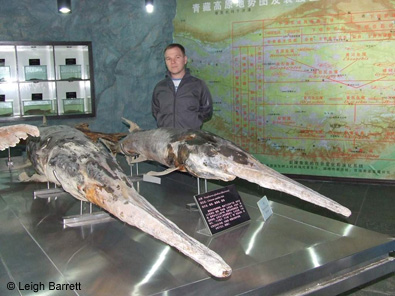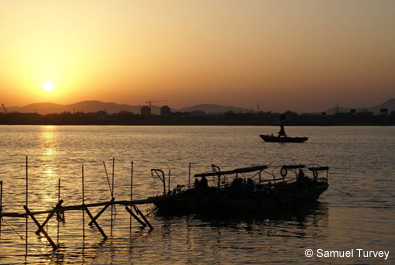Here is the first blog from EDGE’s Dr Sam Turvey about his surveys along the Yangtze River in China, trying to discover the cause behind the disappearance of the baiji, and declines other Yangtze species.
The Yangtze River dolphin or baiji (Lipotes vexillifer), our top-ranked EDGE mammal species, has been the focus of a huge amount of international attention since the 2006 baiji survey in which I took part. Unfortunately this attention all came too late, because the 2006 survey failed to find any evidence that the baiji still survived. Despite conservation concern for over two decades, nothing had actually been done in time to save the species, and it seemed to have finally fallen victim to the rampant overexploitation and industrialisation of the Yangtze River.
But how sure could we be that just because we failed to find any dolphins in 2006, this meant for sure that the species was extinct? Before animals die out they become very rare, which – obviously – makes them very difficult to find. So could there still be a few dolphins hiding away out there, somewhere in the vast Yangtze or its many side-channels? I was doubtful, having spent a lot of time on the river and seen the kind of ecosystem it had now turned into. And if there were any dolphins left, how were we going to try and find them? An intensive boat survey had clearly failed. What other options did we have, if we couldn’t find the animals ourselves?
However, there was still so much that we didn’t know about the environmental problems of the Yangtze ecosystem. We didn’t really have much information on exactly what factors drove the baiji towards extinction, and without this crucial knowledge, would we be able to act in time to prevent other river dolphins from disappearing as well? Furthermore, the baiji’s tragic demise – a worldwide news story – was only a small part of a much wider ecosystem collapse. Chinese researchers have estimated that the river’s population of finless porpoises, the only freshwater porpoise in the world, has declined by over 50% since the 1990s, but again no-one really knows what factors have been directly responsible. Many other species, such as the giant Yangtze paddlefish – the largest freshwater fish in the world, reaching lengths of up to seven metres – are also on the verge of extinction, and many of the river’s most important commercial fish stocks, species such as Reeves’ shad, have also dwindled or vanished entirely. But almost nothing is known about the timing, dynamics, or factors responsible for these massive-scale declines, partly because political attitudes during China’s Great Leap Forward and Cultural Revolution in the 1950s, 1960s and 1970s determined what kind of agricultural and fisheries information should be reported, rather than what was really going on – so there’s almost no base-line data available with which to understand the recent history of the Yangtze’s ecological catastrophe.
The solution? Talk to fishermen. The Yangtze River basin is one of the most over-populated parts of the planet, with estimates suggesting it supports up to 10% of the world’s human population. This staggering statistic indicates just how much human-wildlife conflict there is throughout the region, and the river itself is intensively exploited by people using over 150 different kinds of fishing gear, both legal and illegal. But in order to gain a better understanding of the ecological problems faced by species in the Yangtze, it’s possible to benefit from the presence of people on the river.
Fishermen spend nearly all of their time on the water and depend upon what they can catch for their livelihoods, so they have an expert understanding of the animals that live in the river and when particular species were last seen. So the best way to try and find out if the baiji still survived, or what was happening to other threatened species in the Yangtze ecosystem, would be to talk to people in riverside fishing communities.
And so, in February 2008, I returned to China with my colleague and good friend Leigh Barrett in order to start a wide-scale fishermen interview survey, in collaboration with the Institute of Hydrobiology in Wuhan and supported by funding from the Marine Mammal Commission, Ocean Park Conservation Foundation Hong Kong, People’s Trust for Endangered Species, and donations to the EDGE website. We interviewed fishermen until April, and then returned to China to continue the survey from September to November. During this time, we gathered data from almost 600 fishermen from Yichang to Chongming Island near Shanghai, and in Dongting and Poyang Lakes, covering the entire recent historical range of the baiji. And what the fishermen had to say gave us surprising new information about what had happened to the dolphin.
TO BE CONTINUED



